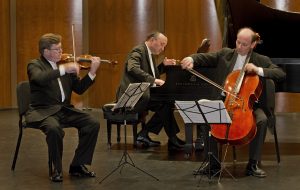SummerFest 2020 Audaciously Purloins Orchestral Gems
For his second night of SummerFest 2020, Saturday August 22, Music Director Inon Barnatan boldly commandeered two large works from the symphonic repertory and made a splendid case for their transmigration into the medium of chamber music.

Inon Barnatan [Photo (c.) Marco Borggreve]
In his day, Beethoven revolutionized piano playing, and, although the fortepianos of his time did to have the strength or brilliance of modern concert grands, he knew how maximize his instrument’s sonic footprint by the sheer density of his voicing. In his piano trio version of the Second Symphony, the piano provides the full-bodied sonority that connotes orchestral breadth, while the bright edge of the violin and cello themes supply the unrelenting drive that propels an orchestra.
From the La Jolla Music Society’s Steinway Barnatan drew a consistently bold sonority that never became clangorous, and when the Larghetto movement asked for more dulcet

Cellist Clive Greensmith with the Montrose Trio [photo (c. Jerry Zolynsky]
Following the Beethoven, Barnatan played his own solo piano transcription of Sergei Rachmaninoff’s Symphonic Dances, and although this brilliant adaptation will not supplant my affection for the original colorfully orchestrated Symphonic Dances, Barnatan made a winning case for the work as a spectacular piano showpiece. Since Rachmaninoff was one of the great piano virtuosos of his generation, I should not have been surprised that the main theme of the opening movement of Symphonic Dances could sound so uncannily pianistic.
But if the piano alone could not match the sonic breadth of a full symphony orchestra, Barnatan resoundingly captured the work’s dramatic intensity and recast its fire in brilliant pianistic terms. His effortless characterizations of the work’s quieter moments brought to mind some of Prokofiev’s “Visions fugitives” or Rachmaninoff’s own delicate “Études- tableaux” compositions for solo piano.
In his introduction to the performance, Barnatan explained that in making his transcription of Symphonic Dances, he was influenced by the composer’s own two-piano transcription of the work. At an elite party in Beverly Hills in 1942, the guests were entertained by a performance of this two-piano version with the composer at one piano and Vladimir Horowitz at the other piano. Ah yes, those were the days!
SummerFest 2020 continues with performances online through Saturday, August 29.

Ken Herman, a classically trained pianist and organist, has covered music for the San Diego Union, the Los Angeles Times’ San Diego Edition, and for sandiego.com. He has won numerous awards, including first place for Live Performance and Opera Reviews in the 2017, the 2018, and the 2019 Excellence in Journalism Awards competition held by the San Diego Press Club. A Chicago native, he came to San Diego to pursue a graduate degree and stayed.Read more…

Another beautiful review my dear Tio! Thank You!